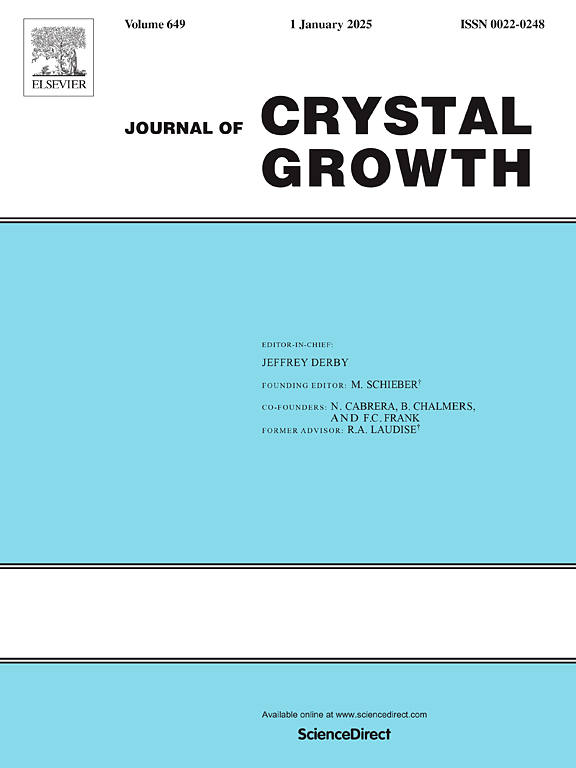Structural, morphological, and improved dielectric properties of PbZr0.52Ti0.48O3 nanoparticles/polycarbonate composites synthesized by using sol–gel method
IF 1.7
4区 材料科学
Q3 CRYSTALLOGRAPHY
引用次数: 0
Abstract
In this work, the PbZr0.52Ti0.48O3 (PZT) nanocrystalline particles were effectively produced using the sol–gel method and then integrated into polycarbonate (PC) to create composites with various PZT concentrations. The produced PZT particles, PC, and PC/PZT composites were evaluated using X-ray diffraction (XRD), Fourier-transform infrared spectroscopy (FTIR), ultraviolet–visible spectroscopy (UV–Vis), and scanning electron microscopy (SEM) techniques. XRD and FTIR investigations verified the development of perovskite PZT nanoparticles free of the pyrochlore phase at 700 °C, with a tetragonal structure and an average crystallite size of PZT nanoparticle is about 56 nm. The XRD pattern revealed its amorphous structure, while the FTIR spectra indicated the presence of C![]() H, C
H, C![]() O, C
O, C![]() C, and C
C, and C![]() O bonds. FTIR spectra showed metal-oxide bonds between 400–800 cm−1, while UV–Vis examination revealed a band gap energy of 2.7 eV. SEM images revealed aggregation among spherical PZT particles. SEM images revealed strong adherence and aggregation of PZT particles within the polymer matrix. The dielectric characteristics of the PC/PZT composites improved with increasing PZT concentrations. The improved interfacial mechanism in ceramic-polymer composites can be used to obtain high dielectric constants.
O bonds. FTIR spectra showed metal-oxide bonds between 400–800 cm−1, while UV–Vis examination revealed a band gap energy of 2.7 eV. SEM images revealed aggregation among spherical PZT particles. SEM images revealed strong adherence and aggregation of PZT particles within the polymer matrix. The dielectric characteristics of the PC/PZT composites improved with increasing PZT concentrations. The improved interfacial mechanism in ceramic-polymer composites can be used to obtain high dielectric constants.
溶胶-凝胶法制备PbZr0.52Ti0.48O3纳米颗粒/聚碳酸酯复合材料的结构、形态及介电性能
本文采用溶胶-凝胶法制备了PbZr0.52Ti0.48O3 (PZT)纳米晶颗粒,并将其整合到聚碳酸酯(PC)中,制备了不同浓度PZT的复合材料。采用x射线衍射(XRD)、傅里叶变换红外光谱(FTIR)、紫外可见光谱(UV-Vis)和扫描电子显微镜(SEM)技术对制备的PZT颗粒、PC和PC/PZT复合材料进行了评价。XRD和FTIR研究证实,在700℃下制备出了不含焦绿石相的钙钛矿型PZT纳米颗粒,具有四方结构,PZT纳米颗粒的平均晶粒尺寸约为56 nm。XRD谱图显示其无定形结构,FTIR谱图显示其存在CH、CO、CC和CO键。FTIR光谱显示金属氧化物键在400-800 cm−1之间,而UV-Vis检测显示带隙能量为2.7 eV。扫描电镜显示球形PZT颗粒聚集。SEM图像显示PZT颗粒在聚合物基体内具有很强的粘附性和聚集性。随着PZT浓度的增加,PC/PZT复合材料的介电特性得到改善。改进的界面机制可用于陶瓷-聚合物复合材料中获得高介电常数。
本文章由计算机程序翻译,如有差异,请以英文原文为准。
求助全文
约1分钟内获得全文
求助全文
来源期刊

Journal of Crystal Growth
化学-晶体学
CiteScore
3.60
自引率
11.10%
发文量
373
审稿时长
65 days
期刊介绍:
The journal offers a common reference and publication source for workers engaged in research on the experimental and theoretical aspects of crystal growth and its applications, e.g. in devices. Experimental and theoretical contributions are published in the following fields: theory of nucleation and growth, molecular kinetics and transport phenomena, crystallization in viscous media such as polymers and glasses; crystal growth of metals, minerals, semiconductors, superconductors, magnetics, inorganic, organic and biological substances in bulk or as thin films; molecular beam epitaxy, chemical vapor deposition, growth of III-V and II-VI and other semiconductors; characterization of single crystals by physical and chemical methods; apparatus, instrumentation and techniques for crystal growth, and purification methods; multilayer heterostructures and their characterisation with an emphasis on crystal growth and epitaxial aspects of electronic materials. A special feature of the journal is the periodic inclusion of proceedings of symposia and conferences on relevant aspects of crystal growth.
 求助内容:
求助内容: 应助结果提醒方式:
应助结果提醒方式:


